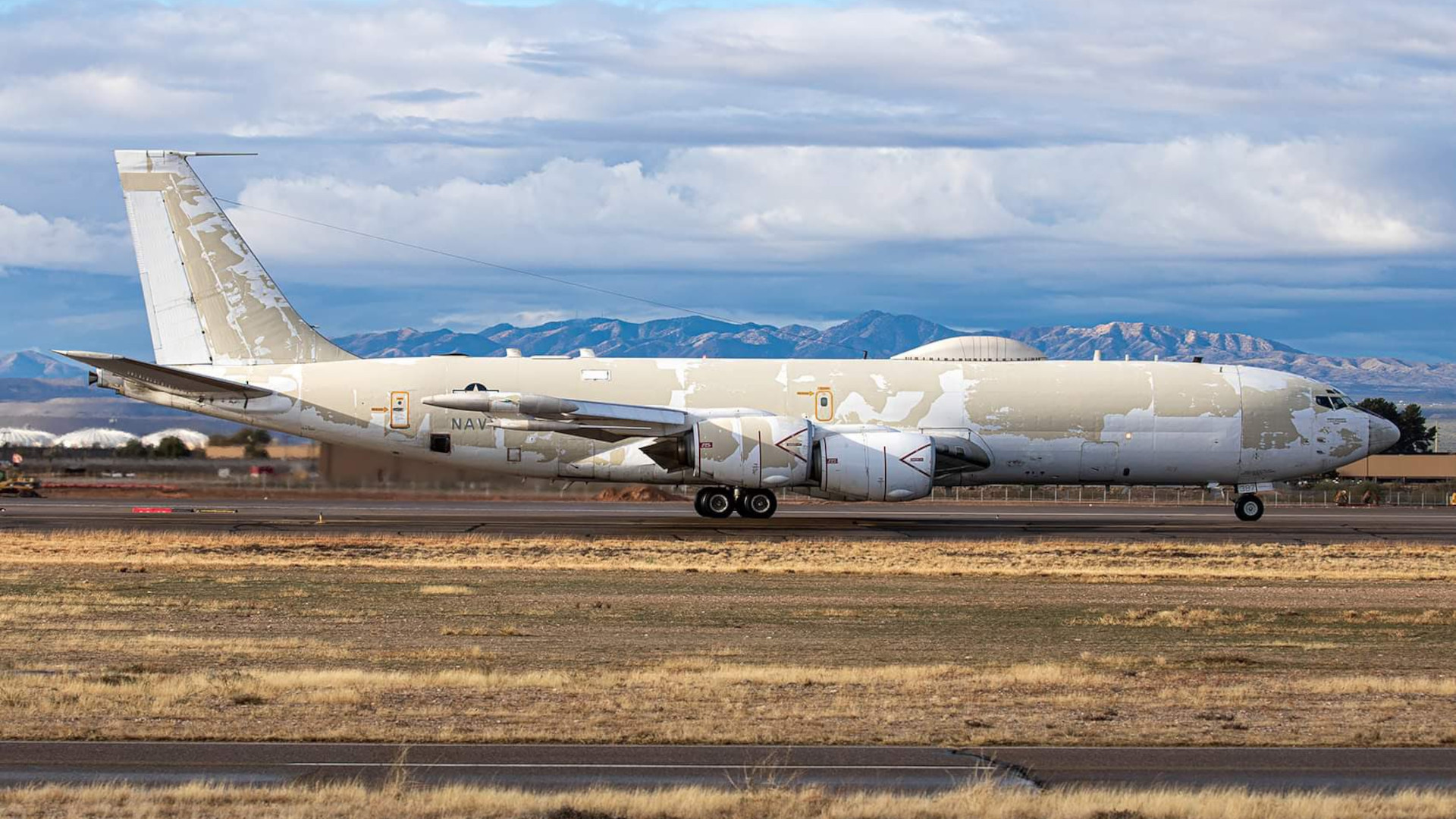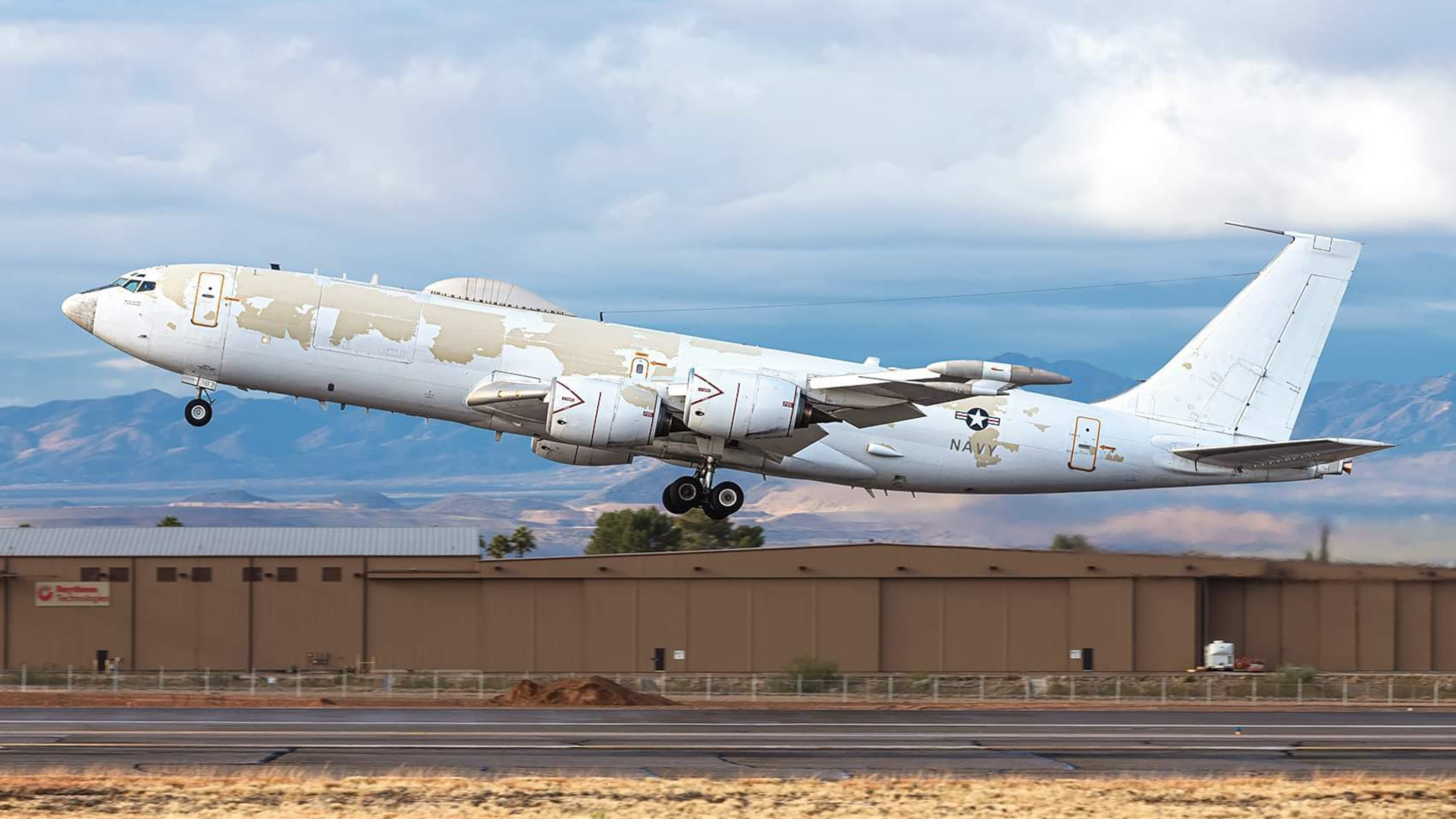A U.S. Navy E-6B Mercury recently turned heads in Tucson, Arizona after it appeared there with what looked to be a heavily weathered paint job. The War Zone subsequently reached out to the Navy for more information and have learned that the service is itself working to get to the bottom of the matter. The Navy’s E-6Bs are so-called ‘doomsday planes’ that serve as airborne command posts for America’s nuclear deterrent triad.
The E-6B in question has the Navy serial number (also known as Bureau Number, or BuNo) 164387. Pictures, seen at the top of this story and below, show the jet with huge patches of paint missing across much its fuselage, tail, and some of its engine cowlings.

Navy ships have often drawn attention in the past due to running rust and other heavy weathering to their paint jobs. However, similar operational wear and tear does not appear to be what has happened to this particular E-6B.
“The paint on E-6B aircraft 164387 is not adhering to the primer,” Naval Air Systems Command’s (NAVAIR) Airborne Strategic Command, Control, and Communications Program Office (PMA-271) told The War Zone in response to our queries about this Mercury. “We are investigating this issue and an appropriate solution.”
“The aircraft remains fully mission-capable and continues to support all assigned tasking,” the statement added.
This can be seen in online flight tracking data about 164387’s activity since leaving Tucson International Airport on January 23. The E-6B then flew to Tinker Air Force Base in Oklahoma, which is the main operating base for the Mercury fleet (16 aircraft in total) and is home to the Navy’s Strategic Communications Wing 1. The wing has two operational E-6B units, Fleet Air Reconnaissance Squadrons 3 and 4 (VQ-3 and VQ-4).
On January 24, 164387 left Tinker for Offutt Air Force Base in Nebraska. Offutt is a major hub for Air Force strategic command and control and intelligence, surveillance, and reconnaissance (ISR) aircraft, as well as being home to U.S. Strategic Command’s (STRATCOM) headquarters. The distressed-looking E-6B has flown at least two sorties from Offutt since arriving there on Wednesday, according to publicly available tracking data from ADS-B Exchange.

Keeping a sufficient number of Boeing 707 airliner-based E-6Bs operational at any one time is key to the U.S. military’s nuclear deterrence posture. These aircraft provide critical and survivable nodes through which orders to carry out nuclear strikes, also known as Emergency Action Messages (EAM), would be transmitted should the need ever arise.
The E-6Bs have a host of specialized capabilities to support this core mission requirement. The jets can extend a five-mile-long antenna to communicate directly with submerged Ohio class nuclear ballistic missile submarines, a central element of what the Navy calls the Take Charge and Move Out (TACAMO) mission. They aircraft also have the ability to initiate the launch of silo-based Minuteman III intercontinental ballistic missiles while in flight. This is in support of an Air Force airborne nuclear command and control mission set commonly referred to by the nickname Looking Glass.

The future of the Looking Glass mission set is currently uncertain. The Navy is working to start supplanting the E-6B fleet with new C-130J-30 Hercules-based doomsday planes by the end of the decade. However, these aircraft will be configured to support the TACAMO mission only.

The Air Force does have four larger Boeing 747-based E-4B Nightwatch aircraft, also known as National Airborne Operations Centers (NAOC), with nuclear command and control capabilities. However, this very small fleet of aircraft is primarily intended to perform a broader continuity of government function, helping to ensure the President and other senior officials can continue to execute their authorities in the event of an extremely serious crisis, as you can read more about here. The Air Force is now moving to replace the E-4Bs with newer Survivable Airborne Operations Center (SAOC) aircraft.
It seems increasingly hard to see how the Air Force can escape a need to pursue a more direct replacement for the E-6B in support of the Looking Glass mission. Some members of Congress are now beginning push for the service to do just this. Prior to the introduction of the dual-mission Mercury, the Air Force had operated a fleet of EC-135 Looking Glass aircraft.
In the meantime, the E-6B Mercury fleet, including BuNo 164387 with its paint peeling for still unclear reasons, will continue to provide essential strategic nuclear command and control capabilities.
Special thanks to Cayden Smith for sharing the pictures of E-6B BuNo 164387.
Contact the author: joe@thedrive.com
